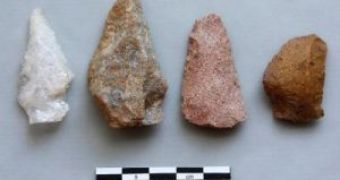The discovery of the oldest known ritual site in Meridional Africa this summer has changed our knowledge of human history.
Long time, scientists have held the supposition that man's first rituals, indicating advanced culture, were carried out over 40, 000 years ago in Europe, only after going out of Africa.
Associate Professor Sheila Coulson, from the University of Oslo, has revealed that modern humans, Homo sapiens, have performed advanced rituals in Africa for 70,000 years.
She made the surprising discovery while studying the origin of the San people (more known as bushmen) (photo above).
Bushmen's original culture is still at the Paleolithic level, of hunters-gatherers.
They represent the oldest living human race, distinct from Black Africans, and thought to roam the Earth for at least 100,000 years and they were the only people in Meridional Africa till the arrival, one millennium ago, of the Bantu tribes from Central Africa (the most known Bantu tribe in the area is Zulu).
Coulson was searching for artifacts from the Middle Stone Age in the Tsodillo Hills (north-western Botswana), still roamed by bushmen and the only heights present for hundreds of kilometers in any direction in the Kalahari Desert, famous for having the largest concentration of rock paintings in the world.
This is still a sacred place for the San, who named them the "Mountains of the Gods" and the "Rock that Whispers".
According to the San creation myth, mankind descended from the python and the ancient, arid streambeds around the hills are said to have been created by the python as it circled the hills in its ceaseless search for water.
The finds depict that ancient people from the area had a specific ritual location associated with the python, held in a little cave on the northern side of the Tsodilo Hills.
This secluded and of difficult access cave was discovered by archaeologists only in the 1990s.
Inside the cave, scientists found a mysterious rock resembling the head of a huge python, six meter long by two meter tall, marked with 3-400 indentations that could only have been man-made.
"You could see the mouth and eyes of the snake. It looked like a real python. The play of sunlight over the indentations gave them the appearance of snake skin. At night, the firelight gave one the feeling that the snake was actually moving".
The work was old and much of the rock's surface was extensively eroded.
Digging in front of the python stone, the researchers discovered many stones that had been used to make the indentations.
Some of these stones were dated 70,000 years old and they found a piece of the wall that had fallen off during the work. More than 13,000 artifacts were recovered, spearheads and articles that could be connected with ritual use and tools used in carving the stone.
The stones of the spearheads did not derive from the Tsodilo area but from hundreds of kilometers away.
The spearheads are better crafted and more colorful than other similar items from the same time and area but the researchers were surprised to find that only the red spearheads had been burned.
"Stone age people took these colorful spearheads, brought them to the cave, and finished carving them there. Only the red spearheads were burned. It was a ritual destruction of artifacts. There was no sign of normal habitation. No ordinary tools were found at the site. Our find means that humans were more organized and had the capacity for abstract thinking at a much earlier point in history than we have previously assumed. All of the indications suggest that Tsodilo has been known to mankind for almost 100,000 years as a very special place in the pre-historic landscape." said Coulson.
A secret small chamber was found behind the python stone and some areas of the entrance to the chamber were worn smooth, pointing that many people had passed through it over the years.
"The shaman, who is still a very important person in San culture, could have kept himself hidden in that secret chamber. He would have had a good view of the inside of the cave while remaining hidden himself. When he spoke from his hiding place, it could have seemed as if the voice came from the snake itself. The shaman would have been able to control everything."
The shamans could have also "disappeared" from the chamber by crawling out onto the hillside through a small shaft. There are only two small paintings in this cave: an elephant and a giraffe, exactly where water runs down the wall.
One San legend speaks about the python, which falls into a body of water and cannot get out by itself.
The python is pulled from the water by a giraffe and the elephant, with its long trunk, is a kind of python representation. "In the cave, we find only the San people's three most important animals: the python, the elephant, and the giraffe.
That is unusual. This would appear to be a very special place. They did not burn the spearheads by chance. They brought them from hundreds of kilometers away and intentionally burned them. So many pieces of the puzzle fit together here. It has to represent a ritual." concludes Coulson.
Archaeologist Christopher Henshilwood had dashed away old theories about oldest human civilizations when he found traces from a Middle Stone Age dwelling in the Blombos Cave in Southern Cape, South Africa.
Photo credit: Sheila Coulson.

 14 DAY TRIAL //
14 DAY TRIAL // 
